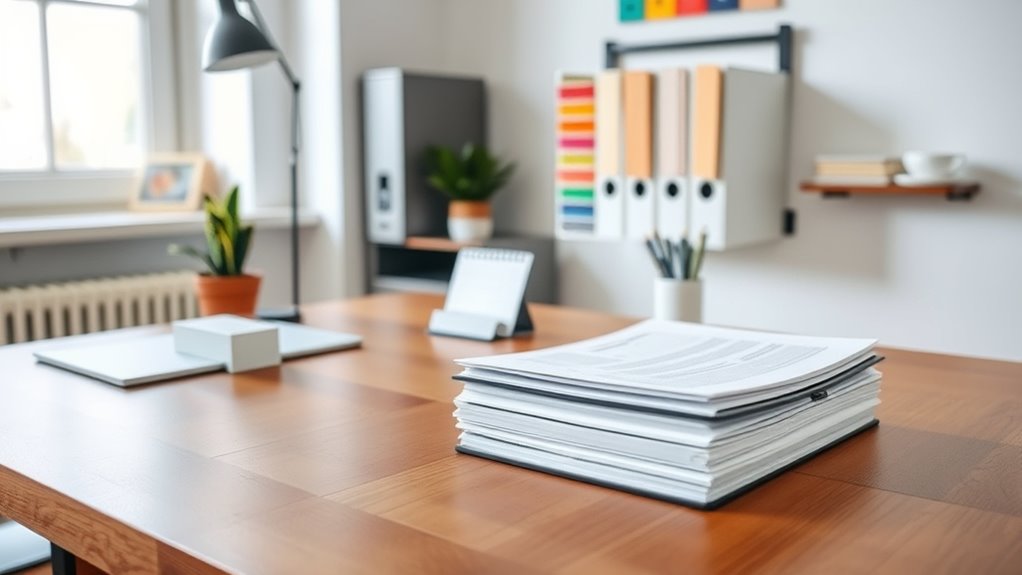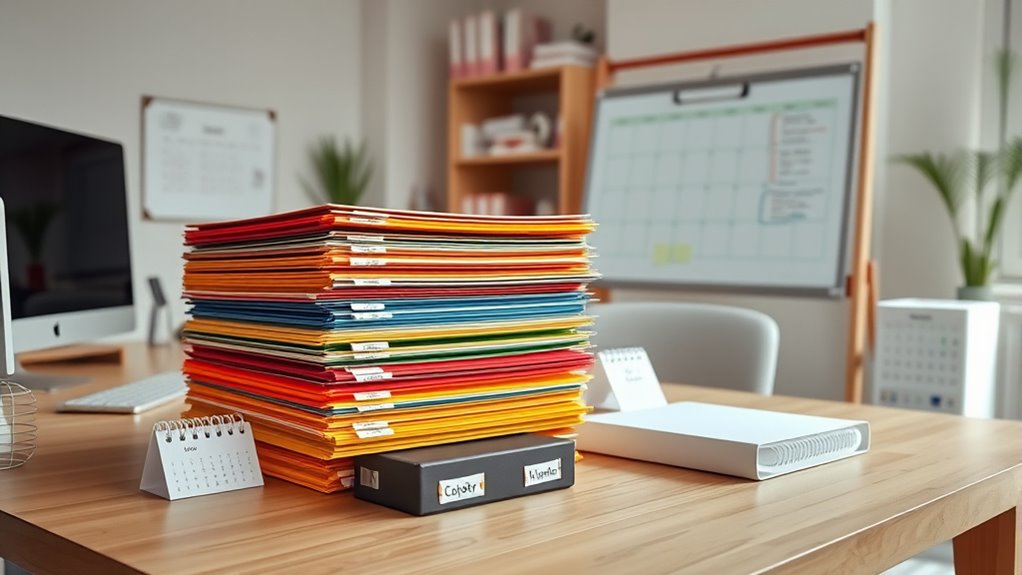Paper clutter explodes when you let incoming documents pile up without a clear system, making it hard to find what you need and causing stress. Without immediate filing or designated spots, papers spread across surfaces, creating chaos. To tame it, establish a consistent filing system, categorize and label your folders, and set regular review times to purge outdated documents. Keep things organized, and you’ll transform chaos into control—continue to learn how a simple system can make a big difference.
Key Takeaways
- Paper clutter explodes when incoming documents are not immediately filed or organized, leading to chaos over time.
- Lack of a consistent system causes papers to accumulate on surfaces, making management overwhelming.
- Digital solutions, like scanning and organized folders, reduce physical clutter and streamline access.
- Regular maintenance, including purging and updating files, prevents papers from piling up again.
- Implementing a structured physical and digital filing system transforms chaos into manageable routines.

If paper clutter has taken over your space, a structured system can make all the difference. One of the main reasons paper piles up is because it’s easy to keep everything, but that quickly leads to chaos. To prevent this, you need a clear method for managing your documents—this is where digital organization and effective filing systems come into play. By shifting some of your paperwork into digital formats, you reduce physical clutter and make important information easier to access. Scanning bills, receipts, and important documents and saving them in organized folders on your computer creates a virtual filing system that’s much easier to maintain than stacks of paper. Digital organization also offers search capabilities, so instead of rifling through piles, you can find what you need with a quick keyword search.
Implementing filing systems is equally important for your physical papers. The key is to create a system that’s simple, intuitive, and sustainable. Start by categorizing your documents into broad groups such as finances, health, home maintenance, and personal records. Within each category, set up labeled folders or filing cabinets with clear, specific labels. For example, under finances, you might have separate folders for bank statements, tax documents, and receipts. Use color-coding if it helps you visually differentiate categories at a glance. Consistency is crucial—whenever you receive new papers, file them immediately into the appropriate folder instead of letting them pile up on your desk or countertop.
Create a simple, labeled filing system and file papers immediately to prevent clutter buildup.
To keep your filing system effective, schedule regular maintenance. Dedicate a few minutes weekly or monthly to review and purge unnecessary documents. Shred outdated or duplicate papers and update your digital files accordingly. This habit prevents clutter from sneaking back in and ensures your system stays functional. Also, consider creating a designated drop zone for incoming papers, so they don’t spread across your workspace before you have a chance to file or scan them. Incorporating organized storage solutions such as labeled bins or folders can further streamline this process.
The combination of digital organization and well-structured filing systems gives you control over paper chaos. It transforms an overwhelming mess into a manageable, even satisfying, routine. Not only does this reduce stress, but it also saves you time when you need to find important documents quickly. Over time, your space becomes more organized, your mind clearer, and your daily life more efficient. With a little effort upfront, you’ll establish a system that keeps paper clutter from exploding again, giving you a tidy space and peace of mind.
Frequently Asked Questions
How Often Should I Review My Paper Decluttering System?
You should review your paper decluttering system at least once a month. This paper review helps you stay on top of new papers, update your decluttering schedule, and guarantee everything is organized. Regular check-ins prevent paper buildup and keep your system effective. By setting a consistent schedule, like every four weeks, you make decluttering a habit and avoid overwhelming clutter.
What Tools Are Best for Organizing Paper Clutter?
When organizing paper clutter, you’ll want versatile tools like labeled file folders and storage boxes for easy access. Consider digital storage options like scanning important documents to reduce physical paper. Recycling strategies are key—regularly shred or recycle outdated papers to prevent buildup. Balancing digital vs. paper storage helps keep your space tidy. Use systems that allow quick sorting and easy retrieval, making ongoing management simple and stress-free.
How Do I Handle Sentimental Paper Items?
When handling sentimental paper items, start by selecting a few meaningful keepsakes and store them in dedicated keepsake boxes for organized keepsake storage. For photos, consider photo preservation techniques like digitizing images to reduce physical clutter. Be selective about what you keep, and avoid creating a backlog. Regularly review and refresh your collection, ensuring that only truly meaningful items are preserved to maintain a clutter-free space.
Can Digital Storage Replace Physical Paper Organization?
You might wonder if digital storage can replace physical paper organization. While digital backup via cloud storage helps declutter your space and keeps important documents accessible, it doesn’t fully replace the sentimental value of physical items. Keep essential papers digitally and scan or photograph sentimental items for digital archives. This way, you enjoy the convenience of digital organization while preserving the emotional significance of physical keepsakes.
What Mistakes Should I Avoid When Managing Paper Clutter?
When managing paper clutter, avoid neglecting digital backups; they’re essential for safekeeping important documents. Don’t forget shredding strategies—discard outdated or sensitive papers securely to prevent buildup. Keep only what’s necessary and set regular times to sort and purge. By staying consistent and using digital backups alongside shredding, you prevent clutter from spiraling out of control, making your space more organized and stress-free.
Conclusion
Once you implement this system, you’ll see paper clutter vanish like snow melting in spring. Imagine your desk as a garden—you plant seeds of organization, water them with routine, and watch chaos turn into clarity. I once found a stack of papers so high it looked like a small mountain; now, it’s just a memory. With consistent effort, you’ll tame your paper jungle, freeing up space and peace of mind.









